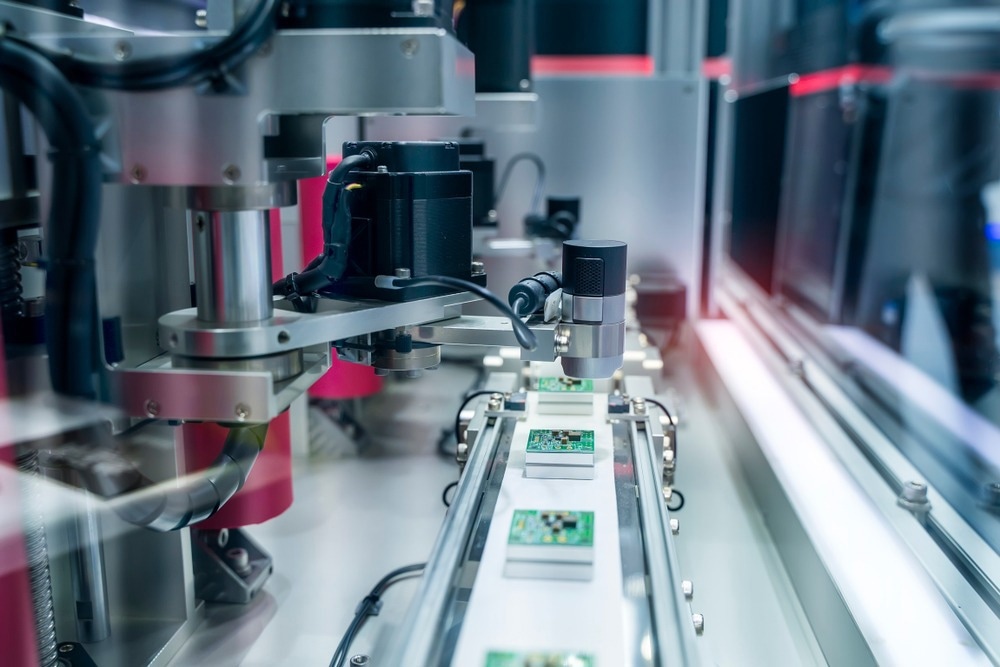In this article, AZoSensors explores the challenge and need to develop cost-effective sensor technologies at scale.

Image Credit: asharkyu/Shutterstock.com
Industrial Sensor Applications are Growing Due to IoT
The adoption rate of the Internet of Things (IoT) is increasing, and many industrial firms across various sectors are utilizing it for multiple purposes.
IoT is increasingly used in industrial settings to improve efficiency and reduce costs.
One application of IoT is in smart energy management, where sensors and devices can be used to monitor and control energy usage, resulting in significant cost savings.
Another application is predictive maintenance, where IoT sensors can be used to monitor the performance of machines and equipment in real time, enabling companies to predict and prevent maintenance issues before they occur.
IoT can also be used to track and manage everything from assets such as inventory, vehicles, and equipment to the quality of products in real-time, enabling companies to identify and address issues quickly, resulting in improved product quality and customer satisfaction.
Finally, IoT can be used to monitor and improve workplace safety and security, detecting hazardous conditions and controlling access to secure areas.
The demand for IoT technology and databases is driving innovation in sensor technology. The ability to monitor and measure distant assets and parameters has created newfound value in predictive analytics and opened doors to monitoring multiple data points from a single platform.
The global market for smart sensors is projected to grow at a rate of 19% per year, with sensors alone estimated to account for $60B by 2022. Manufacturers are responding to this demand with devices that are miniature yet high-performing, energy-efficient, and cost-competitive. The market is evolving quickly, driven by the need for reliable and efficient data collection in a range of industries.
Challenges for Low-Cost Sensor Development: Size, Speed, Power, Functions
As the number of connected devices and implementations increases, it could drive the design of sensors to prioritize function over form.
Companies can invest more in sensor technology as its utility and economic viability become apparent. Development efforts can focus on size, speed, power, and application to meet the demands of a fast-moving supply chain. Sensors can be used not only on moving assets but also on shipped goods, providing supply chain managers with improved visibility and control.
In this dynamic environment, the characteristics of sensors can be refined to provide the best results.
Overall, the supply chain has the potential to drive sensor technology to new levels of innovation, potentially improving operational efficiency and reducing costs.
Connectivity Challenges for Low-Cost Smart Sensors
In response to the needs of an IoT-enabled industrial market, the design and fabrication of low-cost smart sensors have emerged as a critical area of research.
Smart sensors are necessary to ensure accurate and precise measurements for reliable and robust designs. They have been employed in hostile environments, such as biomedical and space applications, meteorology, physical and chemical metrology, electrical and electronic measurements, and machine condition monitoring.
Wireless sensor networks have long-term potential, but they also face optimization problems, including tracking, deployment, and reliability issues. The coverage-related issue is a significant challenge with wireless sensors, affecting the quality of service.
To develop a reliable, economical, and usable network for Industry 4.0, it is essential to address these limitations, including hardware and infrastructure selection, calibration, deployment, and programming model for the sensing network and synchronization.
New Era of Sensor Ubiquity with Long Range, Low Power Sensors
LoRa is a good example of low-cost sensor technology being deployed to meet modern digitized industrial needs. The acronym stands for long-range, low-power wireless radio frequency (RF) technology that connects devices, sensors, gateways, machines, and other subject matter to a home base via the internet.
With its long-range capability and low power usage, LoRa technology is a critical technology to watch for sensors and signals.
These long-range capabilities enable the monitoring of assets and data over large distances, while their low-power consumption makes them ideal for battery-powered devices that require minimal maintenance.
Additionally, LoRa is cost-effective and can be easily deployed in a variety of industrial settings. For instance, it can monitor water levels in irrigation systems or track shipping container locations and conditions.
In the oil and gas industry, LoRa sensors can monitor pipeline pressure and temperature.
UN Air Quality Programme Driven by Low-Cost Sensor Technology
In another key application area, recent advancements in low-cost air quality sensor technology combined with remote sensing and traditional monitoring methods offer new opportunities to understand and communicate air quality.
A UN Environment Programme project is leading the deployment of affordable air quality monitoring networks for assessing air pollution in cities. The project aims to address data gaps in air quality by proactively assessing the viability of fusing satellite and ground observations in developing countries.
This global air quality monitoring framework integrates data from satellites, air quality reference monitors, and low-cost sensor networks.
Continue reading: The Applications of Nanoparticles as Synthetic Catalysts.
References and Further Reading
The Evolution of Sensor Technology. (2020) [Online] Smartsense. Available at: https://blog.smartsense.co/evolution-sensor-technology
Varshnal, A., et al (2021). Challenges in Sensors Technology for Industry 4.0 for Futuristic Metrological Applications. MAPAN. doi.org/10.1007/s12647-021-00453-1.
Why low-cost sensors? Opportunities and Challenges. [Online] UNEP. Available at: https://www.unep.org/explore-topics/air/what-we-do/monitoring-air-quality/why-low-cost-sensors-opportunities-and
Disclaimer: The views expressed here are those of the author expressed in their private capacity and do not necessarily represent the views of AZoM.com Limited T/A AZoNetwork the owner and operator of this website. This disclaimer forms part of the Terms and conditions of use of this website.